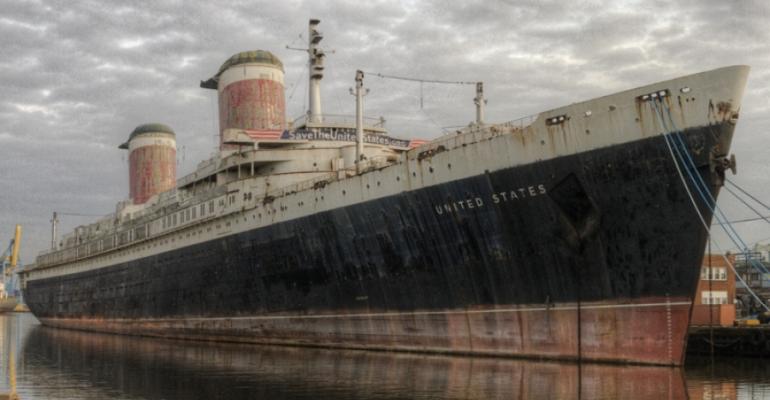The luxury line poured more than $1m into the study and professional evaluation of 'America's Flagship,' convening a world-class team of engineers and experts.
'Unfortunately, the hurdles that would face us when trying to bring a 65-year-old vessel up to modern safety, design and international regulatory compliance have proven just too great to clear in both a technically and commercially responsible manner,' Crystal president and ceo Edie Rodriguez said.
She had personally championed the project, calling the SS United States 'an icon, and so much a part of the American fabric and history.'
As a show of support for the vessel, Crystal will be donating $350,000 to aid in the SS United States Conservancy’s ongoing mission to save the ship. The Conservancy intends to resume its pursuit of stationary redevelopment opportunities.
'Disappointed but not surprised,' is how maritime historian and prolific author Bill Miller, known as 'Mr. Ocean Liner,' reacted to the announcement.
Crystal's decision makes sense, he told Seatrade Cruise News, in light of 'endless problems' to convert/transform a decades-old liner into a modern, efficient, marketable cruise ship.
'The ship itself, still waiting, will no doubt have further reprieves and be a part of varied projects—from hotel-casino to floating power station,' Miller predicted.
Poignantly, he added: 'Her last master, the late Leroy Alexanderson, adored the ship, but suggested, as far back as the early '90s, that she be taken out to sea and gently allowed to go under—the perfect grave for an extraordinary ship.'
The SS United States Conservancy indicated it will not give up.
'While it has been determined that Crystal’s exciting vision for the ship would have required overcoming various technical hurdles and major changes to her historic design, the studies performed have confirmed the ship is structurally sound,' Conservancy executive director Susan Gibbs said. She added: 'America’s Flagship continues to hold enormous potential as a stationary mixed-use development and museum in New York or another urban waterfront setting. The SS United States Conservancy remains deeply committed to saving this unique and powerful symbol of the nation’s strength, history and innovation.'
Led by retired US Coast Guard Rear Adm. Tim Sullivan, Crystal's feasibility study involved a team of maritime experts and engineers conducting numerous assessments on the ship in the Port of Philadelphia, where it has been docked for 20 years. The evaluation and testing included in-depth assessments of the structural condition, underwater inspections of the hull by divers, examination of the fuel and salt water ballasting tanks and a series of intensive engineering studies to deduce what would be needed to bring the liner back into service.
The study concluded that while the SS United States is 'remarkably intact and structurally sound,' modifying the ship for today’s SOLAS standards would require significant changes to the hull that would pose stability challenges. Additionally, the installation of a modern diesel electric propulsion plant would have necessitated altering the existing shaft lines and rebuilding about 25% of the hull to reconfigure the ship to a twin shaft-twin rudder arrangement.
While it was known that the vessel would need to be essentially rebuilt from the inside out, these specific challenges, among others, collectively posed significant risk to the success of the project, Crystal said.
'Our company has great affection for this historic and irreplaceable vessel, and we will be making a $350,000 donation which will help support the Conservancy preserve the vessel through the remainder of the year,' Rodriguez said. She added that Crystal sees the SS United States as an 'American treasure that deserves to be preserved and redeveloped as a stationary destination for future generations to experience and enjoy.'
The Conservancy will immediately restart its aggressive outreach to qualified developers and investors to secure the ship’s future, while continuing its ongoing mission to educate the public about the legacy of the vessel and building its museum collection and archives. A national reunion of former crew members and passengers is planned in Philadelphia on Sept. 17.
Gibbs expressed the Conservancy's deep gratitude to Crystal Cruises for recognizing the SS United States’ historic importance and for working so hard on the ship’s behalf. She called on supporters to continue to work tirelessly to save America's Flagship.
Shattering the trans-Atlantic speed record in 1952, the year of her launch, the United States became a symbol of national pride. The Blue Riband-winning time of three days, 10 hours and 40 minutes (average speed: 35.59 knots) shaved a full 10 hours off Queen Mary's mark.
Yet the United States fell victim to the rise of trans-Atlantic jumbo jet service and in 1969, the liner was mothballed. There have been numerous schemes to bring the vessel back into operation, ranging from a time-share to a floating convention hotel.
Crystal expressed its appreciation to partners and agencies involved in the feasibility study including the US Coast Guard, Atlantic Logistics, the Environmental Protection Agency, the American Bureau of Shipping, the US Maritime Administration, the Seafarer’s International Union and multiple US congressional committees.
Copyright © 2024. All rights reserved. Seatrade, a trading name of Informa Markets (UK) Limited. Add Seatrade Cruise News to your Google News feed.


